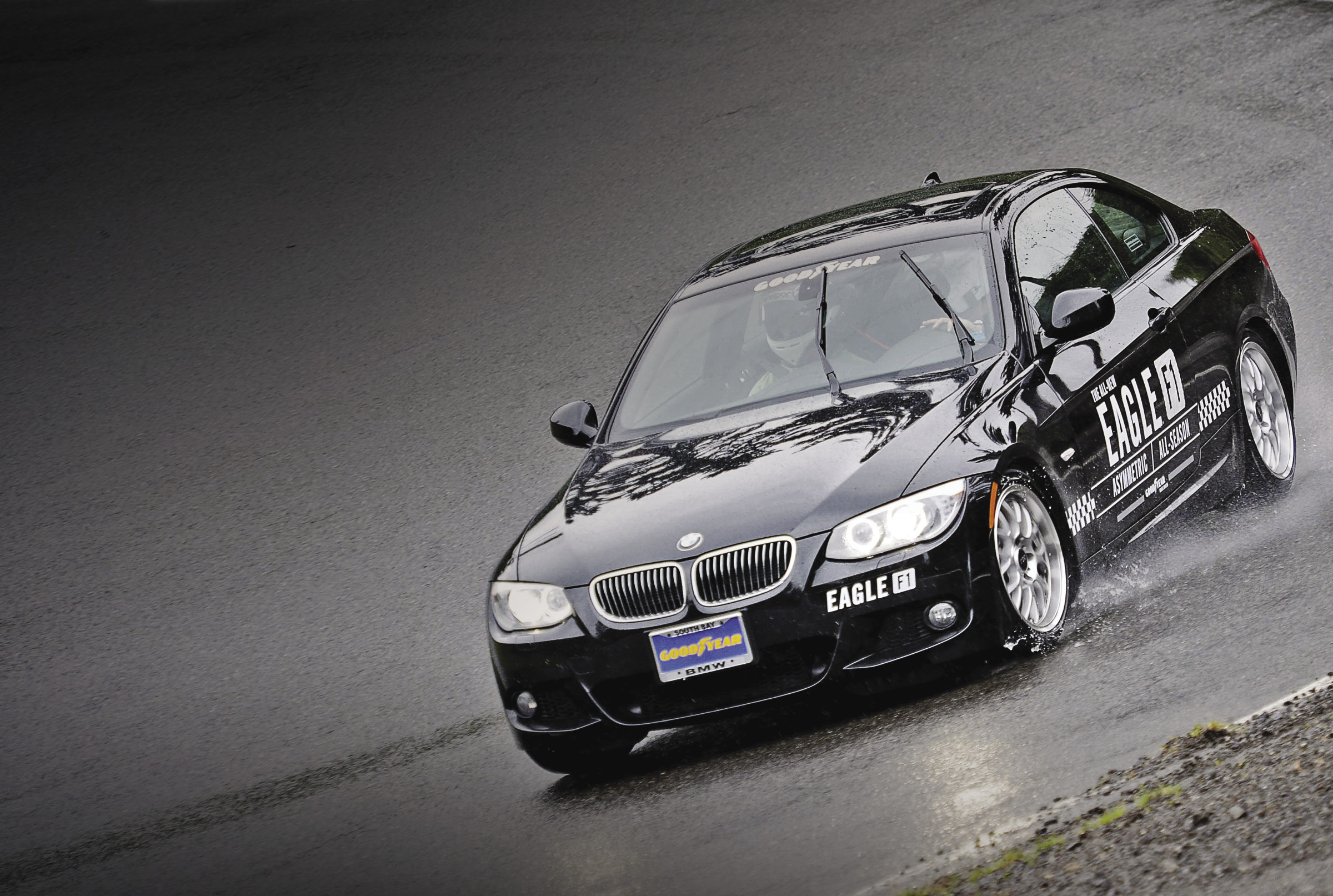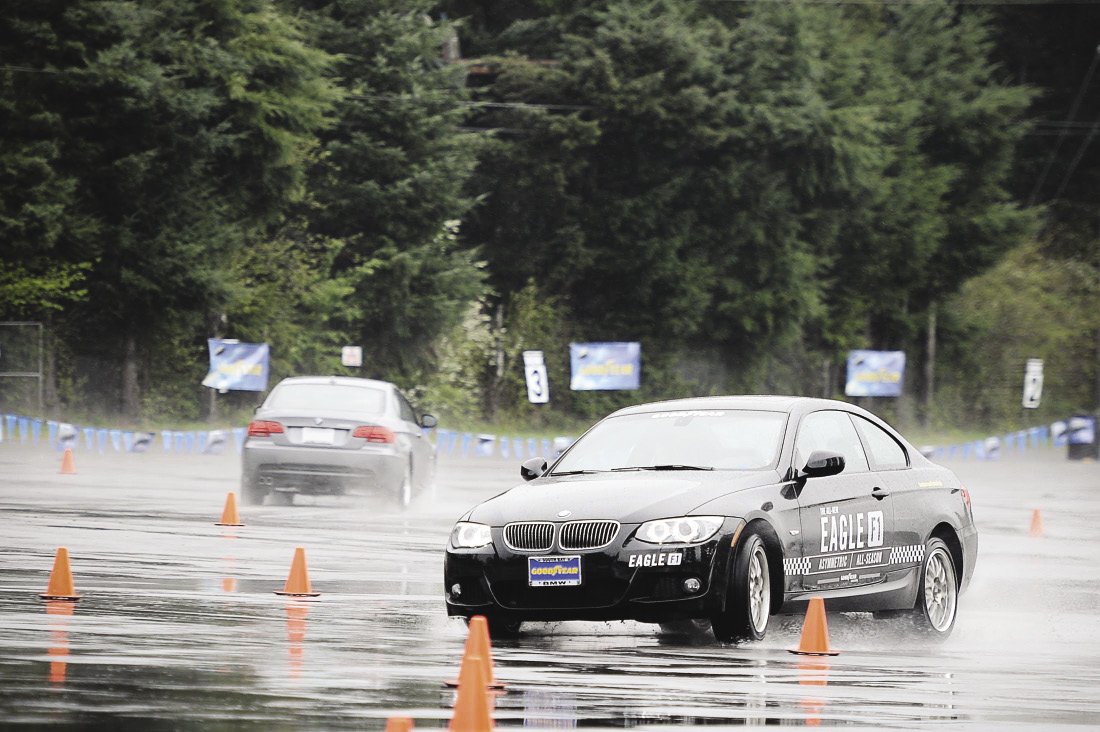
Rainy Seattle an Ideal Proving Ground For Goodyear’s Eagle F1 Asymmetric All-Season
 The Pacific Northwest is undoubtedly one of the most breathtakingly beautiful regions of the United States. Mountains, ocean, dense forests and a diverse wildlife are nearly impossible to resist. One need not be here for very long before becoming completely captive to its many charms. It is indeed a feast for the senses.
The Pacific Northwest is undoubtedly one of the most breathtakingly beautiful regions of the United States. Mountains, ocean, dense forests and a diverse wildlife are nearly impossible to resist. One need not be here for very long before becoming completely captive to its many charms. It is indeed a feast for the senses.
The one thing, however, that might take a little getting used to for those from away is the rain. While technically not the wettest city in America based on rainfall accumulation numbers, it does rain a lot in Seattle especially during the fall and winter.
Although our trip coincided with a time when it tends to taper off (early May), the rain was constant throughout and given the nature of our visit it worked out well for our hosts, Goodyear.
The Akron, Ohio-based tire maker brought a group of media out to Seattle to put their latest high performance tire, the Eagle F1 Asymmetric All-Season, through its paces. As much as we would have liked to have had the opportunity to experience the tire dry conditions, the wet provided some interesting insights into both the Goodyear product and those supplied by the competition.
The new Goodyear Eagle F1 Asymmetric All-Season is a new tire that comes with a slew of number of features designed to improve handling and overall performance in a variety of weather conditions. Among these features is a compound engineered for enhanced performance characteristics such as wet traction and dry handling, two different tread zones (one for all-season and one for dry handling), Tredlock Technology which features microgrooves that provide biting edges for wet traction and better cornering. Finally, Traction Teeth are designed to help provide biting edges which help traction in rain and snow.
The Eagle F1 Asymmetric All-Season is aimed primarily at the replacement tire market, which can be best be described as vast when it comes to North America – 247 million units in 2011 according to figures supplied by Goodyear. The performance tire segment represents the second largest piece of the pie at 56 million (23%), and has grown at a faster pace than the industry as a whole over the past six years. Goodyear expects it to grow by another 2% in 2012.
The rise of the performance tire in the replacement market mirrors its rise in popularity in the Original Equipment Manufacturer (OEM) market, where an increasing number of new cars are being sold with high performance tires. These tires tend to be wider with a lower profile and a higher speed rating than their predecessors and are designed to deliver improved braking, handling and improved all-around performance in both wet and dry conditions.
With all of this floating around in our minds following Goodyear’s morning marketing presentation, the media was marshalled onto the bus for the 30 minute drive to Pacific Raceways in nearby Kent, Washington for a day of road and track testing.
By the time we arrived at the track, the skies were dark (even though it was mid-morning) and the steady rain had produced standing water all over the place. If Goodyear was hoping the rain might relent in order to give us a chance to experience its new tire in the dry, it didn’t take long for those hopes to be dashed. The rain was with us for the entire day.
In addition to an autocross course and a reasonably lengthy jaunt through the country roads surrounding the track was a session on Pacific Raceways’ 2.25 mile, 10-turn road course, which this writer was both excited about and a little concerned for given the wet conditions.
Also along for the journey was a fleet of BMW 335is for the autocross and road course portions of the program (other makes, including Audi, donated cars for the public road segment), and two of Goodyear’s high-performance rivals: Michelin (Pilot Sport A/S Plus) and Bridgestone (Pole Position RE 970 A/S). The competitor tires are the ones that Goodyear had selected when it was looking at industry benchmarks during the development of the Eagle F1 Asymmetric All-Season.
Goodyear asked us to drive the car equipped with the competitor product immediately after one outfitted with their own in order to give us a sense of the differences between the two. The Michelins were selected for the autocross course and the Bridgestones were earmarked for the road course.
 Up first for me was the autocross course, which ran the length of the main parking lot and had both smooth and rough patches on its undulating surface. Standing water was pooling in sections of the course – some offline, some not – which added another variable to the mix.
Up first for me was the autocross course, which ran the length of the main parking lot and had both smooth and rough patches on its undulating surface. Standing water was pooling in sections of the course – some offline, some not – which added another variable to the mix.
I drove the circuit multiple times with both sets of tires and was struck by two things. First, the Goodyear-shod car didn’t slide around as much as the one wearing Pilot Sports did which enabled me to carry more speed. The second thing was the stopping distance, which was noticeably shorter in the Goodyear-equipped car.
The results weren’t being recorded and measured in a scientific manner, so I don’t know what my times were on each circuit, nor do I know what the exact stopping distances were, but I could feel a difference in handling and braking with the Goodyear-equipped car, nevertheless.
The drive on public roads was up next. The Goodyears proved to be quiet in terms of road noise (although the Audi A3 I was driving had something to do with it, I’m sure) and the handling and stopping was impressive. The roads weren’t as wet as the autocross course or the road course, but they were still reasonably damp so I felt they provided a reasonable indicator of how the tires will perform in the wet under normal driving conditions.
After lunch it was time to hit the road course, by which time the rain had begun to pick up again. I was paired with a driving instructor (great idea- more OEM programs should do the same), who gave me some tips on how to drive the course properly in order to evaluate both tires. The first lap was designed to familiarize, and the second was more about going fast, which was more of a challenge given the rainy conditions.
Similar to my experience on the autocross course, the Goodyear-equipped Bimmer inspired more confidence when it came to handling than its competitor. The competition in this instance was Bridgestone, and I was surprised by how squirmy the Potenzas got during cornering and how much noise they’d made in protest.
Given their reputation (and cost), it wasn’t what I was expecting, nor did I quite anticipate the steering wheel being violently jerked back and forth in my hands going down the front straight to prepare for the first corner. The hydroplaning I experienced in the Goodyear-equipped BMW was much milder and didn’t feel as nervous. Much like it was during the autocross portion, the Goodyear car’s handling was more sure-footed, predictable and quieter.
Travelling down the front straight at 110 mph (177 km/h) on a track I’m unfamiliar with in steady rain is something I don’t do lightly, but the fact that I was able to do so with confidence and have a good time in the process speaks volumes about the quality of the new Goodyear Eagle F1 Asymmetric All-Season.

























